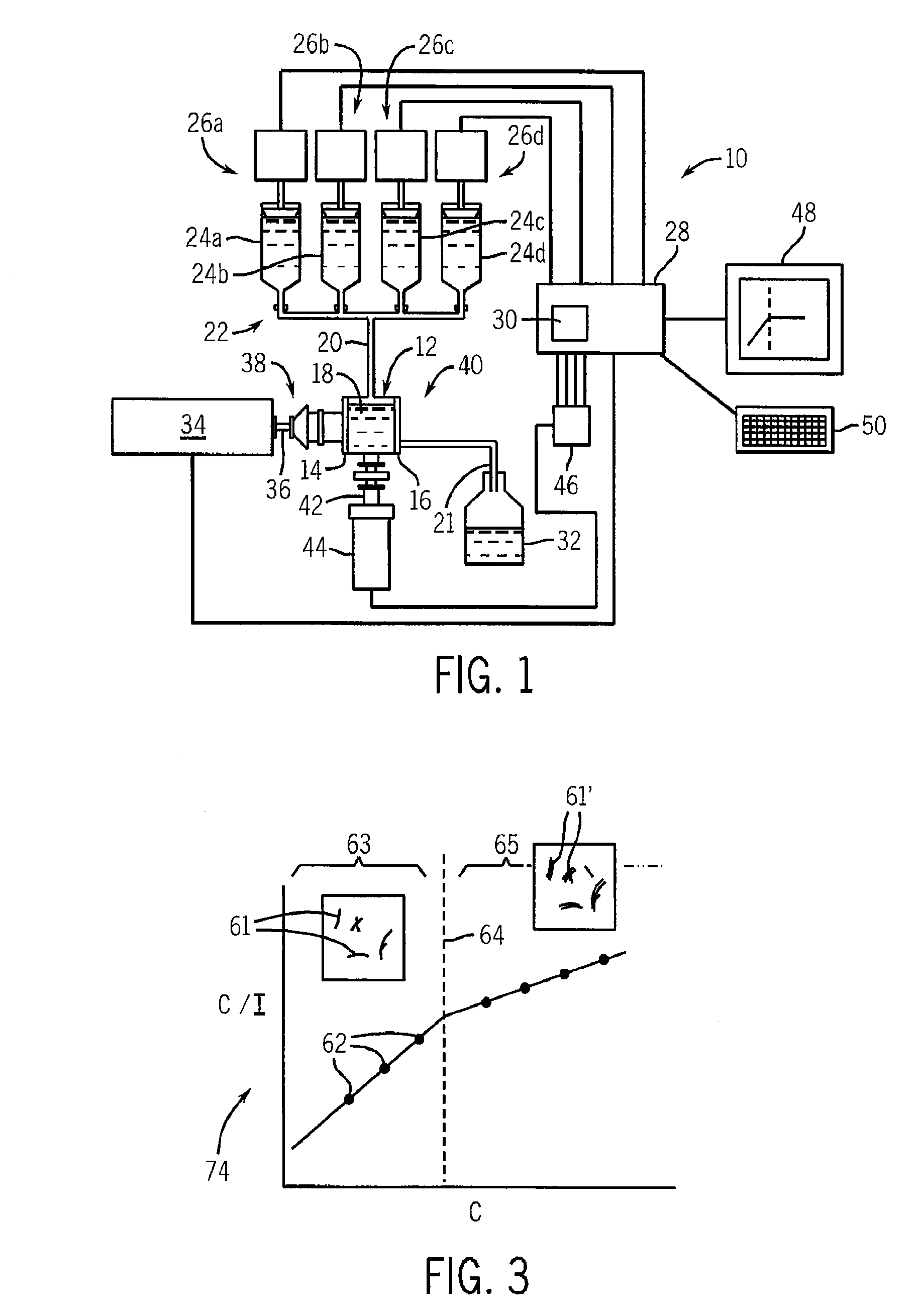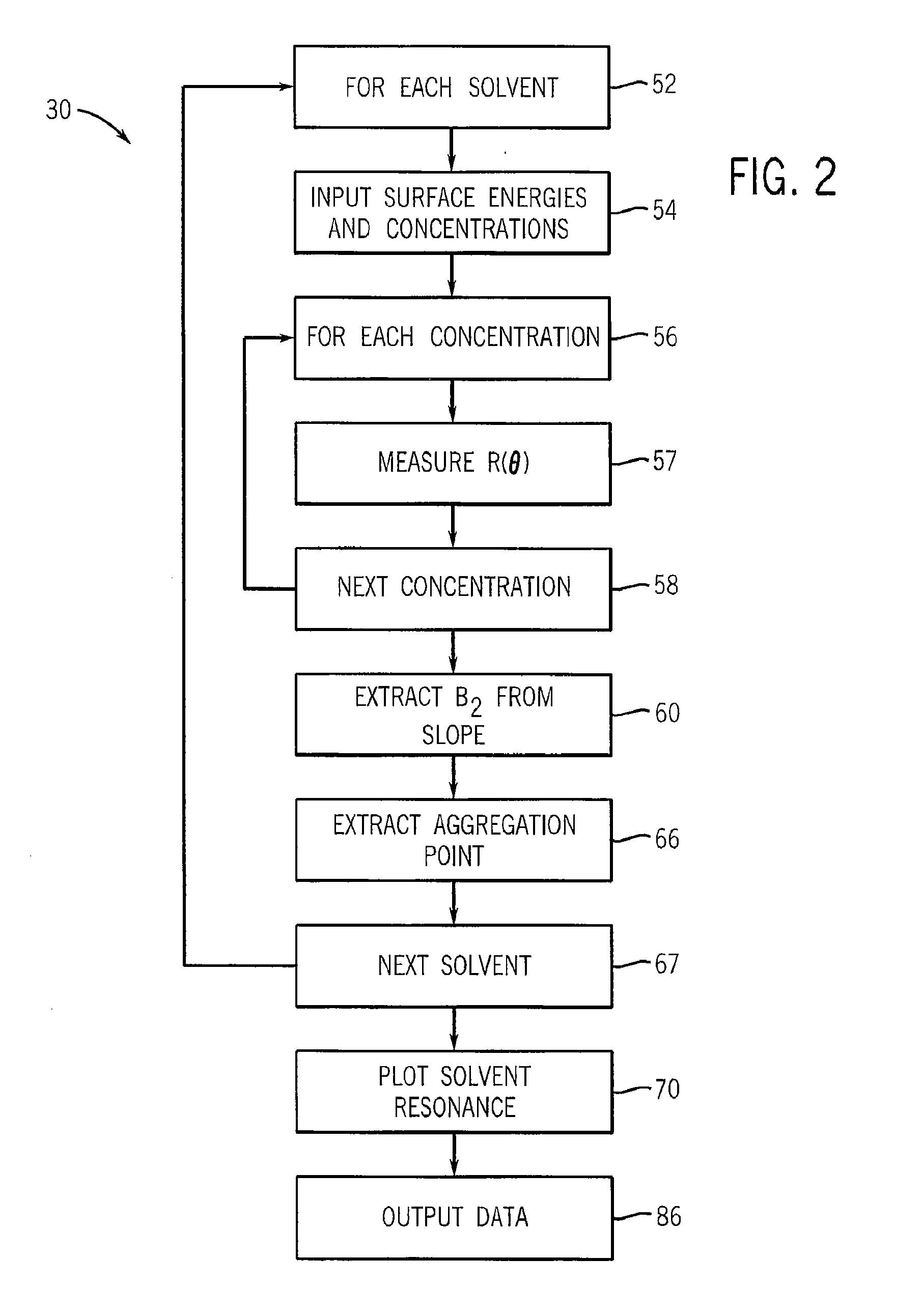Method And Apparatus For Identifying And Characterizing Material Solvents And Composited Matrices And Methods Of Using Same
a technology of composited matrices and solvents, applied in the field of methods and apparatus for identifying and characterizing material solvents and composited matrices and methods of using same, can solve problems such as inability to achieve thermodynamic stability, difficulty in accurately measuring hansen parameters, and failure of techniques to account for some solubility influencing parameters
- Summary
- Abstract
- Description
- Claims
- Application Information
AI Technical Summary
Benefits of technology
Problems solved by technology
Method used
Image
Examples
example ia
Carbon Nanotubes
[0084]Referring to the following Table I, the present inventors have used this technique to evaluate the bundling point or dispersion limit for single-walled nanotubes (SWNT) and multi-walled nanotubes (MWNT) in a solvent of NMP. Referring also to FIGS. 2 and 3, the data representing the light scattering of various concentrations of both SWNT and MWNT in NMP is graphically illustrated. The data plotted against the concentration shows the two slopes of the data located on either side of the bundling point or dispersion limit for the solute in NMP.
[0085]Also, the data used to form the plots in FIGS. 24 and 25 can be utilized in the equations identified above to determine one or more of the various solvent quality values for the solvent. For the data in FIGS. 24 and 25, the determination of the bundling point and the solvent quality values of the second virial coefficient B2 and Chi χ are represented in Table I as follows:
TABLE IB2 (mol ml / g2)AggregationChisolute / pre-po...
example ib
Carbon Nanotubes
[0087]To attempt to arrive at an optimal solvent that has an intrinsic property closer to the calculated resonance from the plot shown in FIG. 4, it is also possible to provide other solvents and solvents formed of mixtures of solvents. Referring now to FIG. 5, a plot similar to FIG. 26 is illustrated in which the solvent quality values in the form of χ for mixtures of various solvents calculated according to the above procedure are plotted versus the surface tension for each of those mixtures. Some of the values for the particular solvents and mixtures of solvents of interest, such as NMP, N8P, cyclohexyl-2-pyrrolidone (CHP), and N-ethyl-2-pyrrolidone (NEP) and the ionic liquid (1-Ethyl-3-methylimidazolium acetate (C8H14N2O2)) commercially available from BASF under the tradename BASF BASIONIC BC01, are shown below in Table II:
TABLE IIMeasured Values of SWNT and MWNT in Various SolventsSolventSurface TensionChi(mixtureDispersion(room temperatureValueSoluteratio)Limit...
example ic
Functionalized Carbon Nanotubes
[0098]Referring to FIG. 29, present technique also works with nanotubes functionalized with octyl decanoic acid (ODA). For example, ODA functionalized SWNT nanotubes have an optimum solvent / matrix Hildebrand Parameter of between 18-21 MPa1 / 2 and an ideally near 19.5 MPa1 / 2. Optimal solvents, for example, approximated by CH2Cl2 / CHCl2, achieve a value of χ less than about −0.2 while other solvents such as chloroform, THF and o-C6H4Cl2 obtained values of χ less than zero all indicating true thermodynamic solvency. Thus the present invention works not only with pristine macromolecules but can be used to provide improved solvents or functionalized macromolecules. Optimally tuning composite material properties that utilize functionalized nanomaterials are an important embodiment of this invention because some covalent bonds to the matrix will optimize properties such as strength and matching the surface energy of both matrix and incorporant with further opti...
PUM
| Property | Measurement | Unit |
|---|---|---|
| area | aaaaa | aaaaa |
| thickness | aaaaa | aaaaa |
| surface tension | aaaaa | aaaaa |
Abstract
Description
Claims
Application Information
 Login to View More
Login to View More - R&D
- Intellectual Property
- Life Sciences
- Materials
- Tech Scout
- Unparalleled Data Quality
- Higher Quality Content
- 60% Fewer Hallucinations
Browse by: Latest US Patents, China's latest patents, Technical Efficacy Thesaurus, Application Domain, Technology Topic, Popular Technical Reports.
© 2025 PatSnap. All rights reserved.Legal|Privacy policy|Modern Slavery Act Transparency Statement|Sitemap|About US| Contact US: help@patsnap.com



